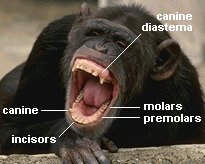Glossary of Terms
A B C D E F G H I J K L M N O P Q R S T U V W X Y Z
Select the first letter of the word you are seeking from the list above
to jump to the appropriate section of the glossary or scroll down to it.
- A -
- adaptive radiation
- the relatively rapid expansion and diversification of an evolving group of organisms as they adapt to new ecological niches. Adaptive radiation is the process by which one species evolves into two or more species. This occurs as a result of different populations becoming reproductively isolated from each other, usually by adapting to different environments.
-
anthropoid

- any animal of the primate suborder Anthropoidea. Monkeys, apes, and humans are the living anthropoids.
-
arboreal

- tree-living; referring to animals that are adapted to life in the trees. Arboreal animals spend most of their time scampering around in trees rather than on the ground, in the air, or water.
-
australopithecines

- members of any species of the genus Australopithecus. They lived during the Pliocene and early Pleistocene geological Epochs in Africa (i.e., ca. 4.2-1.2 million years ago). Australopithecines and humans are hominids. One or more species of australopithecines probably were our ancestors.
Back to Top
- B -
-
bipedal

- a two-footed, upright form of locomotion typical of hominids. Human walking is an example of bipedalism.
Back to Top
- C -
-
canine
 teeth
teeth - the comparatively pointed teeth on either side of the incisors, at the front of the mouth of mammals. There is one canine tooth in each of the four quadrants of the mouth. Canine teeth are mainly used to pierce and tear food.
-
canine
diastema

- a space or gap between the canine and adjacent teeth. It allows room for the point of the protruding opposite canine tooth and thereby permits the upper and lower teeth to bite together. Normally, there is a diastema opposite each of the four canine teeth if the canines are significantly longer than the other teeth.
-
carnivorous

- eating only meat. Animals that have this sort of diet are carnivores. See herbivorous and omnivorous.
-
Cenozoic Era

- the most recent geological era, dating from about 65 million years ago to the present. It is the era in which the mammals flourished. It began as the last dinosaurs became extinct, at the end of the Mesozoic Era. Most of the placental mammals and all of the primates evolved during the Cenozoic.
-
chronometric
 date
date - a date that places an event in its chronological position with reference to a universal time scale such as a calendar. Such dates usually are given in terms of the number of years before or after a calendar starting point. For instance, 1950 B.C. was 1950 years before the beginning date of the Gregorian calendar, which is commonly used today. See relative date.
Back to Top
- D -
-
dentition

- a term referring to teeth.
Back to Top
- E -
-
ecological
niches

- specific micro-habitats in nature to which populations or organisms adapt. They are usually seen in terms of being food getting opportunities in the environment.
-
evolution

genetic change in a population of organisms that occurs over time. The term is also frequently used to refer to the appearance of a new species. More specifically, it is change in the frequencies of alleles in a population's gene pool from one generation to the next.
Back to Top
- F -
-
flora and fauna

- terms of Latin origin that are commonly used in the sciences to refer to the plants (flora) and animals (fauna) in an environment.
-
foramen
magnum

- the hole at the base of a skull through which the spinal cord passes. Literally, foramen magnum means a "large hole or opening" in Latin. The position of the foramen magnum is a strong indicator of the angle of the spinal column to the head and subsequently whether the body is habitually horizontal (like a horse) or vertical (like a monkey).
Back to Top
- G -
-
genera

- see genus.
-
genus
 (plural genera
(plural genera
 )
)
- a group of closely related species. In the Linnaean classification system, genus is the category immediately above species.
- genetic bottle-necking
- a dramatic reduction in genetic diversity of a population or species resulting from an ecological crisis that wipes out most of its members. The limited genetic diversity of the few survivors is the pool from which all future generations are based. This phenomenon is also referred to as a "bottle-necking effect."
-
gracile

- graceful, slender, and delicate. This 17th century English term is used to describe the body characteristics (especially bones) of the early australopithecines and the earliest humans.
-
Great Rift Valley

- a long depression in Southwest Asia and East Africa caused by the movement of tectonic plates, largely beginning during the Oligocene Epoch. In Africa, it extends from Ethiopia southwest 1200 miles through the lake regions. Many of the early hominid sites are in this valley system.
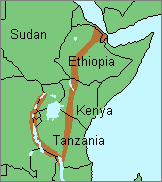 |
- H -
-
herbivorous

- eating only vegetable foods. Animals that have this sort of diet are herbivores or vegetarians. See carnivorous and omnivorous.
-
hominid

- any species of the primate family Hominidae. The gorillas, chimpanzees, bonobos, australopithecines, and humans are hominids.
-
hominin

- any species of the primate tribe Hominini. The australopithecines and humans are hominins
-
hominini

- see hominin.
-
hominoid

- any species of the primate superfamily Hominoidea. All hominids and apes are hominoids.
Back to Top
- I -
Back to Top
- J -
Back to Top
- K -
Back to Top
- L -
Back to Top
- M -
-
mammal

- an animal in the class Mammalia.
-
Mammalia

- a class of warm blooded, usually hairy animals, that feed their young with milk secreted by the mammary glands of females. The Mammalia include monotremes, marsupials, primates, cats, dogs, bears, hoofed animals, rodents, bats, seals, dolphins, whales, and several other groups of animals.
-
Mesozoic Era

-
Metatheria

- the infraclass of therian mammal species in which females bear their young in an immature condition (while still in the early fetal stage) and then permit their further infant development in an abdominal pouch covering their mammary glands. Compared to the delayed births of placental mammals, this is inefficient in keeping young infants alive. Metatherian mammals are also called marsupials. Included in this infraclass are kangaroos, koalas, opossums, etc.
-
Miocene
Epoch

- the fourth geological epoch of the Cenozoic Era. The Miocene occurred approximately 23-5.3 million years ago.
-
molar
 teeth
teeth - the comparatively large grinding teeth at the back of the mouth in mammals. In hominids and all other anthropoids, there are normally 3 molars in each quadrant of the mouth.
the geological era immediately preceding the Cenozoic Era and dating approximately 251-65.5 million years ago. The Mesozoic was the era in which the dinosaurs flourished and the first mammals and birds evolved. Note: some geologists suggest that the Mesozoic most likely started 245-248 million years ago.
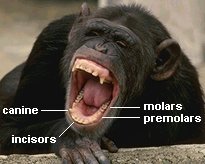 |
- N -
- natural selection
- an evolutionary mechanism that occurs when some individuals of a population are better able to adapt to their environment and, subsequently, produce more offspring. Nature, in effect, selects which members of a population are fit to survive long enough to reproduce. Differential productive success between individuals is the key. Those who produce more offspring have a greater influence on the gene frequencies of the next generation. This mechanism of evolutionary change was first articulated by Charles Darwin.
- Neandertals

- the most well known late archaic Homo sapiens. They lived mostly in Europe and the Near East from 150,000 years ago or even earlier until at sometime after 28,000 years ago. There is an on-going debate as to whether they should be considered Homo sapiens or a distinct but related species. If they were members of our species, they were a different variety or race (Homo sapiens neanderthalensis). On the other hand, if they were different enough to be a distinct species, they should be considered to be Homo neanderthalensis.
Back to Top
- O -
- Oligocene
Epoch

- the third geological epoch of the Cenozoic Era. The Oligocene occurred approximately 33.9-23 million years ago.
-
omnivorous

- the ability to live by eating both meat and vegetable foods. See carnivorous and herbivorous.
Back to Top
- P -
-
paranthropoids

- members of the hominin genus Paranthropus described first in the 1930's by Robert Broom. Since the 1960's, most paleoanthropologists have not classified them as a separate genus but, rather, as members of the genus Australopithecus. From this perspective, the paranthropoids were the robust australopithecines. They lived during the late Pliocene and early Pleistocene geological Epochs in Africa (i.e., ca. 2.5-1.2 million years ago). .
-
pelvis

- The pelvis consists of the bones in the hip region. The upper leg bones (i.e., femurs) connect to the torso at the pelvic girdle and the spinal column ends there as well.
- plate tectonics
- see tectonics.
-
Pliocene Epoch

- the fifth geological epoch of the Cenozoic Era. The Pliocene occurred approximately 5.3-2.6 million years ago. The australopithecines and earliest humans evolved during the Pliocene Epoch.
-
premolar
 teeth
teeth
-
prosimians

Back to Top
- Q -
-
quadrupedal

Back to Top
- R -
-
radiometric
 dating
dating - referring to techniques for chronometric dating based on known half-lives of particular isotopes or the rate of other cumulative changes in atoms resulting from radioactivity. Examples include electron spin resonance, fission track, potassium-argon, radiocarbon, and thermoluminescence dating.
- relative date
- a date that gives the time of an event only with reference to another event that is not worldwide in scale. It only indicates that one event occurred earlier or later than another. For instance, the observation that strata 2 is younger than strata 1 beneath it in a geological deposit does not provide information about how many years ago strata 2 was laid down. It only indicates its age relative to strata 1. In addition to the use of stratigraphy, relative dating methods include biostratigraphy and fluorine analysis dating. See chronometric date.
- robust
- a term used by paleoanthropologists to refer to a big boned and muscular body. The robust species of early hominids were Australopithecus robustus, boisei, and aethiopicus.
Back to Top
- S -
-
sagittal crest

- a ridge of bone projecting up, from front to back, along the top midline of the skull. It serves as a muscle attachment area for the temparalis muscles that extend up both sides of the head from the mandible (jaw). The presence of a sagittal crest indicates that there are exceptionally strong jaw muscles. Some Australopithecus afarensis and the robust australopithecines (Australopithecus robustus, boisei, and aethiopicus) had sagittal crests. Among the living primates, the most prominent sagittal crests are found on adult male gorillas. Humans do not have them.
-
savanna

- a tropical or subtropical grassy plains. Savannas are usually the habitat of larger herbivores and their predators. The first hominids apparently evolved on and near African savannas.
-
sexual
dimorphism

- referring to anatomical differences between males and females. Primate males are usually significantly larger and more muscular than females.
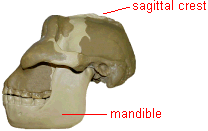 |
Back to Top
- T -
-
tectonics

- the study of the earth's crustal structures, such as continental plates, and the forces that cause them to change shape and move relative to each other.
Back to Top
- U -
Back to Top
- V -
Back to Top
- W -
Back to Top
- X -
Back to Top
- Y -
Back to Top
- Z -
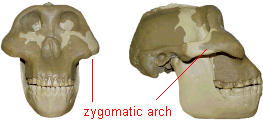 |
-
zygomatic arch

- a bony arch extending horizontally on either side of the face just below the eyes on primates and many other vertebrates. The major jaw muscles pass under these two arches on their way up to the temporal areas of the skull for attachment.
Back to
Top
Copyright © 1999-2013 by Dennis
O'Neil.
All rights reserved.
illustration credits
